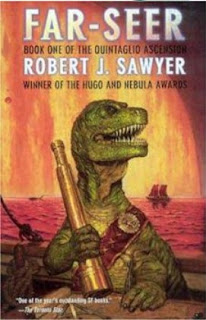Far-Seer - A Review
At first, the premise sounds a little silly. It's long been speculated that intelligent life would have arisen among dinosaurs had a meteor impact not wiped them out. So what if intelligent life did, in fact, arise among dino-like reptiles?
That's the basic idea behind Robert J. Sawyer's book, Far-Seer. It follows the adventures of Afsan - a dino-like version of Galileo - who uses a "far-seer" (a kind of early telescope) to work out that their world was not at the center of their solar system.
But this is not the Planet Earth! This world is a moon orbiting a Jovian gas-giant in an entirely different solar system. What's more, it is tidally locked, so that the one, lone continent is always on the far side. (That would mean there would have to be a large concentration of iron, off-center from the core, or else the continents would always face the planet, but Sawyer doesn't go into that.) In order for these technology-weilding dinos (known as Quintaglios) to see the gas giant, they must sail half way around the world to the far side. And then they see it - a planet so large that they literally named it "the Face of God."
Afsan, however, works out that the "Face of God" is nothing of the kind. He realizes that it is a planet, and that their world is actually a moon. His discovery, naturally, smacks of heresy, flying in the face of centuries of tradition. What's more, he realizes that their world faces a terrifying fate. Upon observing that other gas-giant planets have a system of rings, he works out how such rings must have formed. A moon, after slowly spiraling inwards over millions of years, would be torn apart by gravitational tidal forces to make an accretion disk of rings. By extension, that meant that their moon, their world, would eventually be torn apart as well! In fact, it is surmised that this is the main reason why their world is so fraught with earthquakes and volcanism. Afsan's scientific discoveries must not only overcome religious prejudice, they must also become the foundation of a new scientific endeavor - they must leave their moon and colonize the outer planets. And they must do so quickly, before their world is destroyed! Afsan works out that they have only a few hundred years at most.
One might think that a book with an all-reptile cast would be boring. But Sawyer makes it work, and work well! The reader finds himself caught up in the exotic yet oddly familiar culture, and the Quintaglios seem oddly human. They have fingers, retractable claws, and verbal speech. This is a world much like the European Renaissance. It is a world of wooden ships, hereditary kings, religious leaders, and scientists. The discoveries Afsan makes are based on simple observations, yet his conclusions regarding them are profound.
This is book one of a trilogy known as the Quintaglio Ascension, chronicling the rise of this civilization from technologies of rope and steel to one of air flight and then space flight. It is among Sawyer's earlier works, yet his early writing is every bit as compelling as his later writing.
So far, I'm nearing the end of book 2, and loving it. Highly recommended.
Eric
*




Comments
Post a Comment